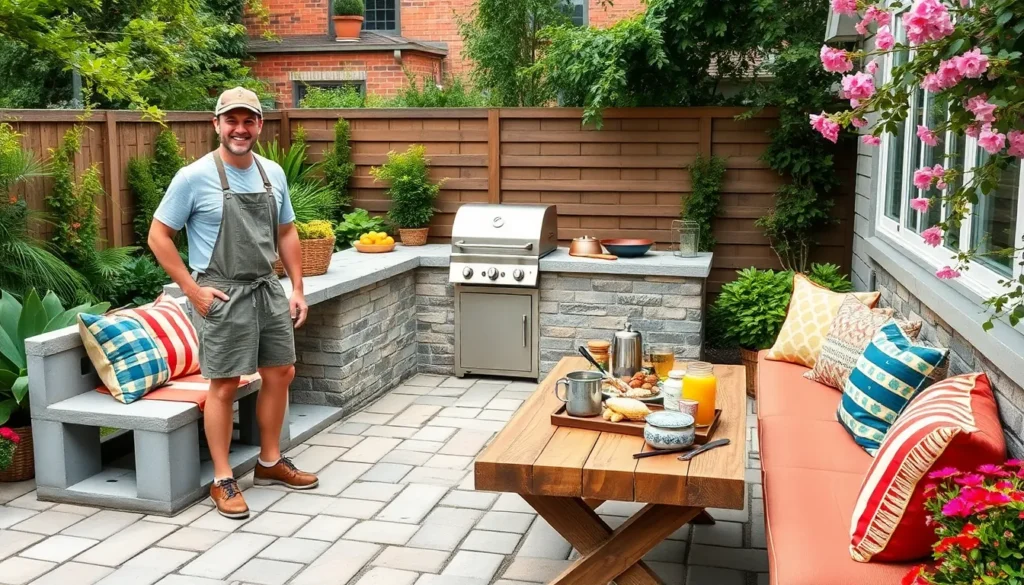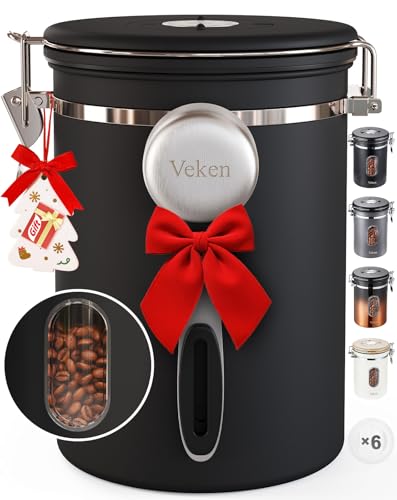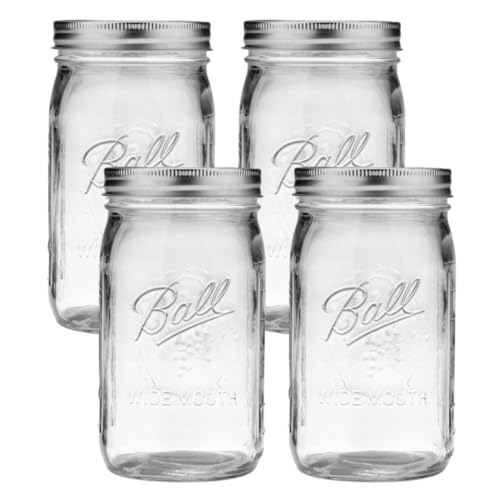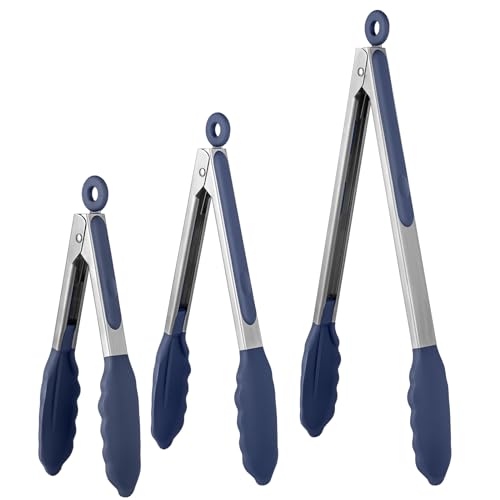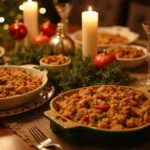Creating the perfect backyard BBQ setup doesn’t have to drain your wallet. We’ve discovered that with some smart planning and creative thinking you can transform your outdoor space into an amazing grilling paradise without very costly.
Whether you’re working with a tiny patio or a sprawling yard we’ll show you how to maximize your space and budget. From DIY grill stations to budget-friendly seating answers there are countless ways to create an inviting atmosphere that’ll have your neighbors asking for your secret.
The best part? Most of these ideas use materials you probably already have or can find at your local hardware store for a fraction of restaurant prices. We’re talking about transforming your backyard into the ultimate entertaining space where memories are made and burgers are perfectly grilled – all while keeping your budget intact.
Create a Designated Grilling Zone With Affordable Materials
Establishing a dedicated grilling area doesn’t require expensive landscaping or professional installation. Smart material choices and simple techniques can transform any outdoor space into a functional BBQ zone that looks professionally designed.
Use Concrete Pavers for a Budget-Friendly Foundation
Concrete pavers offer exceptional value for creating a stable grilling surface at a fraction of the cost of poured concrete. We recommend 12×12 inch pavers from home improvement stores, which typically cost $1-3 each and provide excellent heat resistance. Level the ground by removing grass and adding a thin layer of sand before placing pavers in your desired pattern.
Square pavers create clean lines around rectangular grills, while hexagonal options add visual interest to circular setups. Most homeowners can complete a 6×8 foot paver foundation using 12 pavers for under $40. Gaps between pavers allow for drainage and can be filled with decorative gravel or left open for a modern look.
Build a Simple Gravel Base for Stability
Gravel bases provide superior drainage and prevent settling issues that plague grass or dirt surfaces. Purchase pea gravel or crushed stone from industry supply stores for approximately $30-50 per cubic yard. Calculate your needs by measuring length × width × 2 inches deep, then divide by 324 to determine cubic yards required.
Rake the gravel evenly across your designated area and compact it using a hand tamper or the back of a shovel. This method works exceptionally well for portable grills and creates a professional appearance that complements any patio design. Edge the gravel area with industry timber or metal edging strips to prevent spreading.
Repurpose Bricks for Rustic Charm
Reclaimed bricks transform ordinary grilling areas into charming outdoor kitchens with authentic character. Source free or low cost bricks from demolition sites, classified ads, or salvage yards where prices range from $0.10-0.50 per brick. Clean bricks thoroughly with a wire brush and water before installation.
Arrange bricks in herringbone patterns for visual appeal or lay them in simple running bond formation for easier installation. Fire bricks work best directly around grill areas due to their heat resistance, while standard bricks suit surrounding walkways and borders. Complete a 4×6 foot brick foundation using approximately 150 bricks for under $75 including sand for leveling.
Design a Functional Prep Station Using DIY Solutions
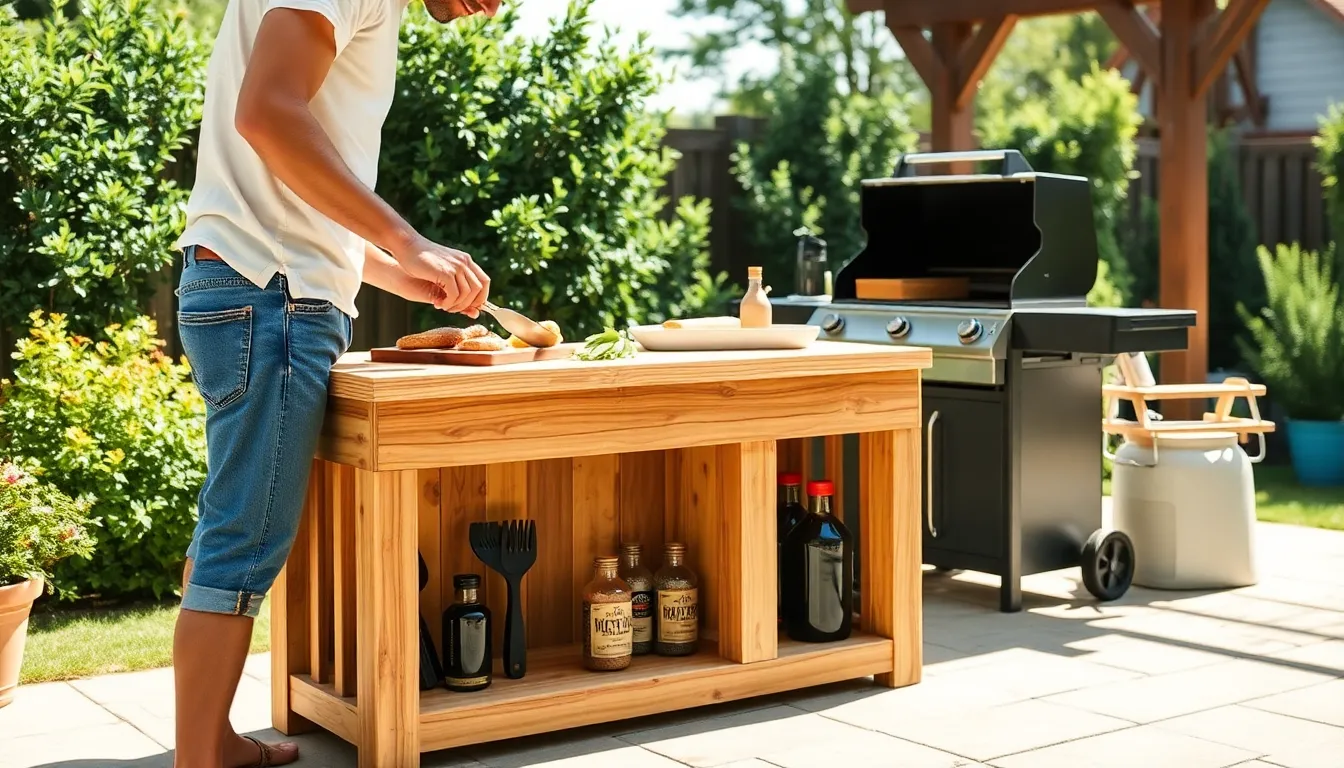
Creating an efficient prep station doesn’t require expensive outdoor kitchen setups. We can transform common household items and affordable materials into highly functional preparation areas that make our backyard BBQ experience smoother and more organized.
Convert a Rolling Cart Into a Mobile Prep Area
Rolling carts offer unmatched versatility for our outdoor cooking needs. We can transform an old filing cabinet into a mobile kitchen station by adding casters to the bottom and installing hooks along the sides for hanging utensils and towels. This approach gives us storage capacity in the drawers while creating a movable prep surface that follows us around the grill area.
Medical carts from thrift stores work exceptionally well for this purpose since they’re built for mobility and durability. We simply add a cutting board on top and organize our BBQ tools in the existing compartments. The wheels allow us to position our prep station wherever we need it most, whether that’s next to the grill for quick access or near the dining area for serving.
Adding a small cooler underneath or attaching a paper towel holder to the side maximizes our cart’s functionality. We can customize the storage by installing small bins or containers in the drawers to keep seasonings, marinades, and small tools organized and easily accessible.
Build a Simple Wooden Counter With Storage
Wooden counters provide dedicated workspace while keeping costs minimal through smart material choices. We can construct a basic frame using 2×4 lumber and top it with an affordable butcher block or even exterior grade plywood sealed with marine finish for weather protection.
Building storage underneath maximizes our investment by creating dedicated spaces for plates, serving platters, and BBQ accessories. We install simple shelves or even repurpose plastic storage bins that slide in and out like drawers. This design keeps everything organized while maintaining easy access during busy cooking sessions.
The key to success lies in proper weather protection through quality outdoor sealant or paint. We recommend marine grade finishes that protect against moisture and temperature changes, ensuring our DIY counter lasts through multiple seasons of outdoor entertaining.
Repurpose an Old Table for Food Preparation
Vintage sewing tables make excellent BBQ prep stations because of their built in storage and sturdy construction. We can sand down the surface and apply outdoor paint or stain to create a weather resistant workspace that adds character to our patio area. The original storage compartments become perfect spots for holding utensils, seasonings, and serving supplies.
Dining tables that have seen better days get new life when we convert them into beverage and food stations. Adding casters transforms a stationary piece into a mobile prep area that we can reposition based on our entertaining needs. We often add hooks along the edges or install a towel bar underneath for convenient access to cleaning supplies.
Converting antique sewing machine tables requires minimal effort but delivers maximum impact for our outdoor space. We preserve the original pedal mechanism for visual interest while using the flat surface for food preparation and the built in storage for BBQ essentials. These unique pieces become conversation starters while serving practical purposes in our backyard setup.
Establish Comfortable Seating Areas Without Breaking the Bank
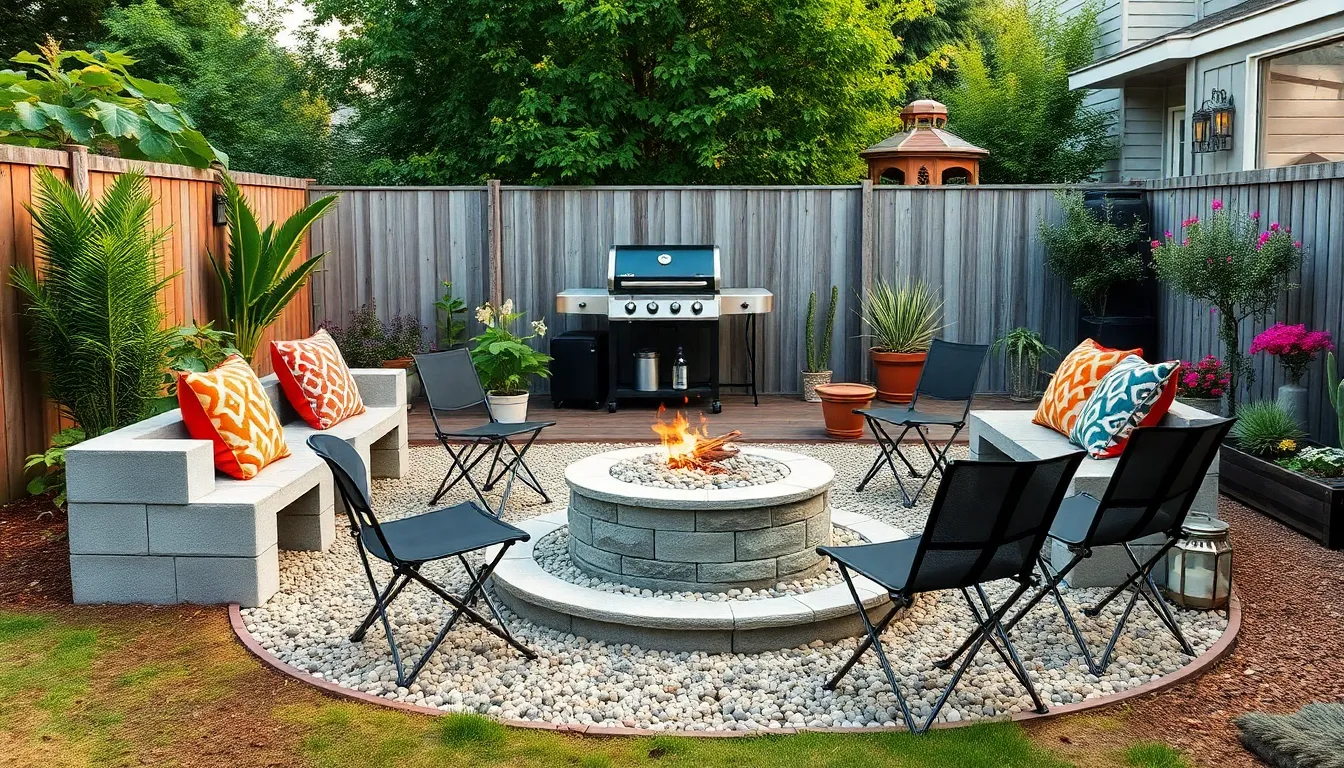
Building comfortable seating for your backyard BBQ area doesn’t require expensive outdoor furniture purchases. We’ve discovered several creative answers that maximize comfort while keeping costs minimal.
Use Cinder Blocks and Cushions for Bench Seating
Stack cinder blocks to form the base of sturdy benches throughout your patio space. We recommend purchasing standard 8x8x16 inch blocks, which typically cost under $2 each at most home improvement stores.
Top these foundations with weather-resistant cushions to create comfortable seating that rivals expensive outdoor furniture. Waterproof cushions protect against moisture while providing the comfort your guests expect during long BBQ sessions.
Position these bench structures along the perimeter of your grill area to maximize seating capacity. We’ve found that a single row of cinder blocks supports up to 300 pounds, making them suitable for multiple guests.
Paint the blocks in colors that complement your outdoor decor to achieve a more finished appearance. This customization transforms industrial materials into attractive seating answers that guests won’t recognize as budget alternatives.
Create a Fire Pit Seating Circle With Gravel and Chairs
Arrange outdoor chairs in a circle around a DIY fire pit positioned on a gravel bed. Gravel provides excellent drainage while preventing grass damage, and it costs significantly less than concrete or stone installations.
We suggest using pea gravel or decomposed granite for the base, which typically runs $30-50 per cubic yard. This affordable material creates a defined space that separates your fire pit area from the main BBQ zone.
Choose portable chairs that you can easily move between the fire pit and dining areas. Folding chairs or lightweight resin chairs offer flexibility without the expense of matching outdoor furniture sets.
Install the fire pit about 10-15 feet from your main grilling area to avoid smoke interference. This strategic placement allows guests to enjoy warmth and ambiance while staying clear of cooking activities.
Repurpose Pallets Into Outdoor Furniture
Transform wooden pallets into sofas, coffee tables, and additional benches for your BBQ area. We recommend sourcing heat-treated pallets marked with “HT” stamps to ensure they’re safe for outdoor furniture projects.
Sand the pallets thoroughly to remove splinters and rough edges before assembly. Apply exterior wood stain or paint to protect against weather damage while matching your preferred aesthetic.
Stack pallets vertically to create sofa backs, then secure them with wood screws for stability. Add outdoor cushions on top to complete the transformation from shipping materials to comfortable seating.
Build coffee tables by attaching casters to single pallets, creating mobile surfaces for drinks and snacks. We’ve found that adding a piece of tempered glass on top elevates the appearance while providing a smooth surface for serving.
Create storage compartments within pallet furniture by adding hinged tops or fabric bins. This dual-purpose approach maximizes functionality while maintaining the rustic charm that makes pallet furniture so appealing for outdoor spaces.
Add Shade and Weather Protection on a Tight Budget
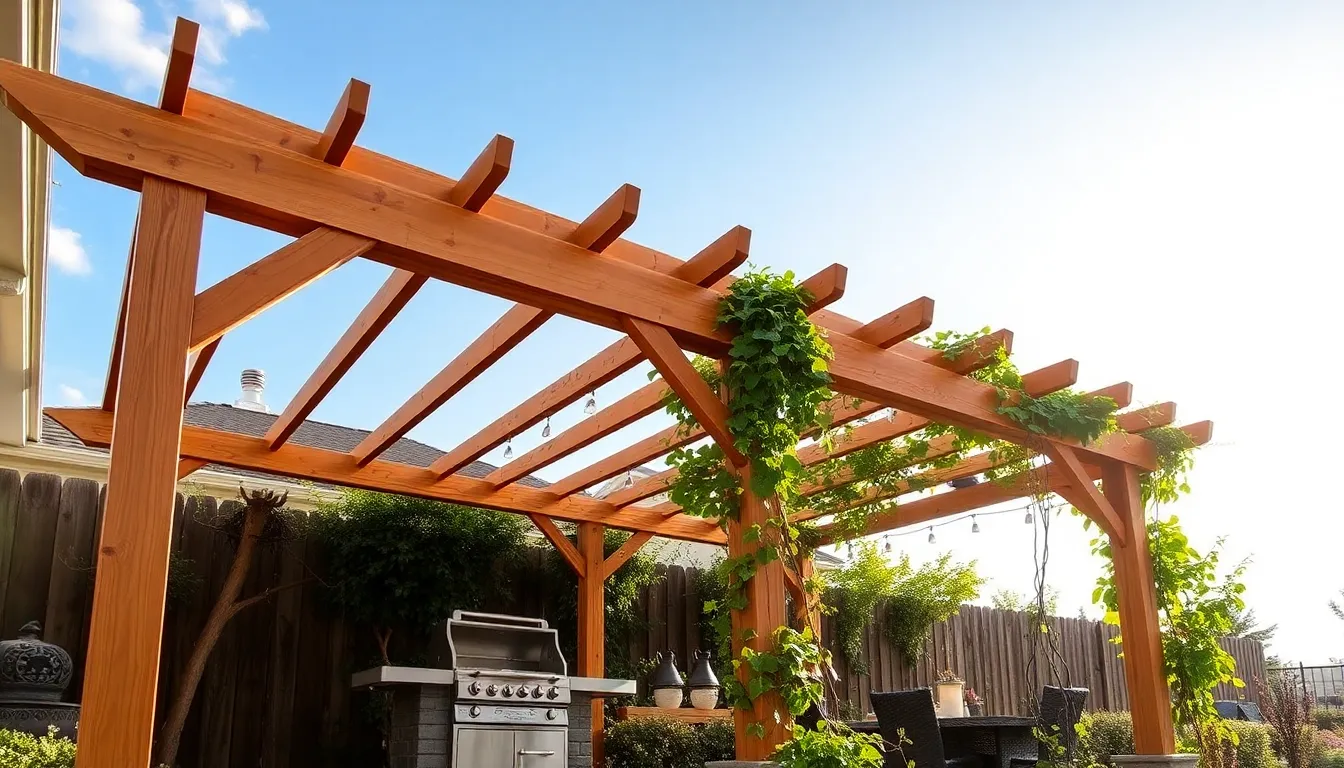
Creating comfort in our outdoor cooking space doesn’t require expensive installations. Smart shade answers protect us from harsh sun and unexpected weather while keeping costs minimal.
Install a Simple Pergola Using Basic Materials
Building a DIY pergola transforms our grill area into a stylish outdoor room using affordable lumber from local hardware stores. Pine and cedar offer excellent value while providing the durability we need for weather resistance. Basic designs feature vertical posts and horizontal cross beams that create an attractive overhead structure without complex joinery or advanced carpentry skills.
We can complete most pergola projects with minimal tools including a drill, saw, and level. Standard 4×4 posts anchor the structure while 2×6 or 2×8 beams create the overhead framework. Pre-cut lumber reduces preparation time and ensures consistent dimensions throughout our project.
Construction costs typically range from $200 to $400 depending on size and wood selection. Hardware stores often provide cutting services that eliminate the need for specialized equipment. Weekend completion becomes achievable when we organize materials and follow straightforward building plans.
Use Drop Cloths or Tarps as Temporary Canopies
Drop cloths and tarps provide immediate shade relief for under $30 per covered area. Canvas drop cloths offer superior durability compared to plastic alternatives while maintaining professional appearance. Heavy duty tarps withstand wind and light rain when properly secured with bungee cords or rope.
Strategic placement over our grill or seating area creates instant comfort during hot summer days. We can attach these temporary covers to existing structures like fences, trees, or pergola frames. Grommeted edges allow easy installation and removal for storage during severe weather.
Multiple attachment methods include tie downs to fence posts, tree branches, or portable stakes driven into the ground. Adjustable height creates optimal coverage while maintaining clearance for safe grilling operations. Seasonal storage in garages or sheds extends the lifespan of these affordable shade answers.
Plant Fast-Growing Vines for Natural Shade
Fast growing vines like morning glory and sweet peas create living shade walls that enhance our outdoor atmosphere. These climbing plants establish quickly during spring planting and provide dense coverage by midsummer. Natural screening costs less than $20 for seeds or starter plants while delivering years of shade benefits.
Morning glory vines grow 6 to 10 feet in a single season and produce colorful blooms throughout summer months. Sweet peas offer fragrant flowers and attract beneficial pollinators to our garden space. Both varieties thrive in average soil conditions with minimal maintenance requirements.
Installation requires simple trellises or wire supports attached to existing structures like fences or pergola posts. We can create attractive living walls that filter sunlight while maintaining airflow around our cooking area. Strategic planting positions maximize shade coverage during peak grilling hours while adding natural beauty to our outdoor space.
Incorporate Smart Storage Solutions for Grilling Essentials
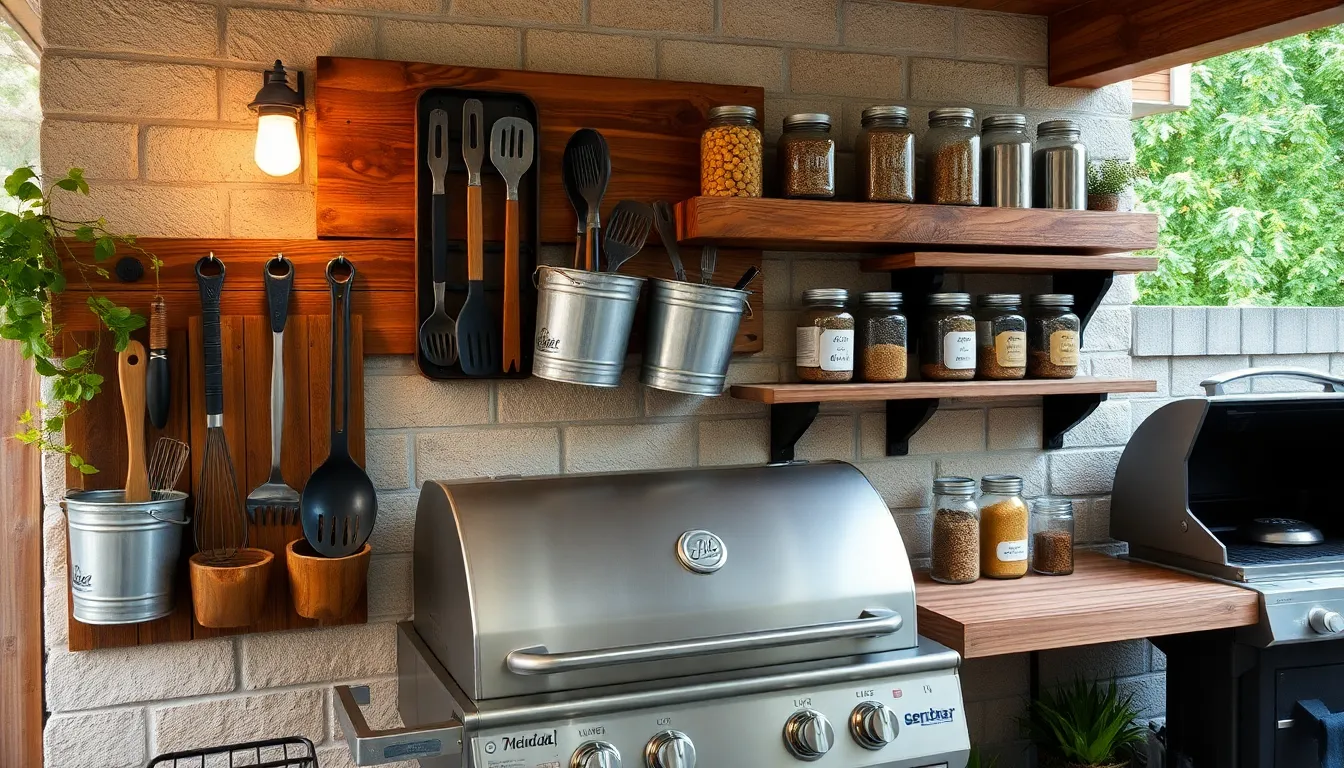
Organized storage keeps your grilling tools accessible while maintaining a clean and functional outdoor cooking space. These DIY answers help you create efficient storage systems without stretching your budget.
Build a Simple Tool Organizer From Reclaimed Wood
Building a tool organizer from reclaimed wood provides an inexpensive way to keep grilling utensils organized while adding rustic charm to your patio. We recommend constructing a wall-mounted rack using salvaged fence boards or old pallet wood that can hold spatulas, tongs, and cleaning brushes.
Design your organizer with multiple compartments and hooks to accommodate different tool sizes and shapes. Create slots for long-handled tools like spatulas and forks while adding small cubbies for thermometers and grill brushes. The natural weathering of reclaimed wood complements outdoor settings perfectly and requires minimal finishing.
Secure the organizer to your fence or grill area wall using heavy-duty screws and wall anchors. Position it within arm’s reach of your grill to ensure tools remain accessible during cooking. This storage solution typically costs under $20 in materials and can be completed in a weekend afternoon.
Use Galvanized Buckets for Utensil Storage
Galvanized buckets offer affordable and durable storage that can be hung or placed strategically around your grilling area. These metal containers hold spatulas, tongs, brushes, and other essential tools while keeping them neatly arranged and within easy reach during cooking sessions.
Mount buckets directly to fence posts or grill side tables using simple brackets or hooks. Fill each bucket with exact tool categories to create an organized system that prevents searching for misplaced utensils. The galvanized coating resists rust and weather damage, making these containers ideal for permanent outdoor use.
Consider using different sized buckets for various storage needs throughout your BBQ setup. Large buckets work well for long-handled tools while smaller ones accommodate cleaning supplies and accessories. This versatile storage method costs approximately $5 to $15 per bucket and requires no special installation skills.
Create a Spice Station With Mason Jars
Mason jars transform into an organized spice station that keeps your favorite rubs and seasonings handy while adding a personalized touch to your BBQ setup. Attach multiple jars to a wooden board or arrange them on a dedicated shelf to create easy access to all your grilling spices.
Label each jar clearly with waterproof markers or adhesive labels to identify contents quickly during cooking. Choose wide-mouth jars for easier filling and measuring while selecting sizes that match your typical seasoning quantities. The clear glass allows you to monitor spice levels and refill as needed.
Protect your spice station from moisture by positioning it under cover or using airtight mason jar lids. Create a portable version by mounting jars in a wooden carrying caddy that moves easily between storage and grilling areas. This organization system costs less than $30 for a complete setup and keeps seasonings fresh and accessible.
Enhance Ambiance With Budget-Friendly Lighting Options
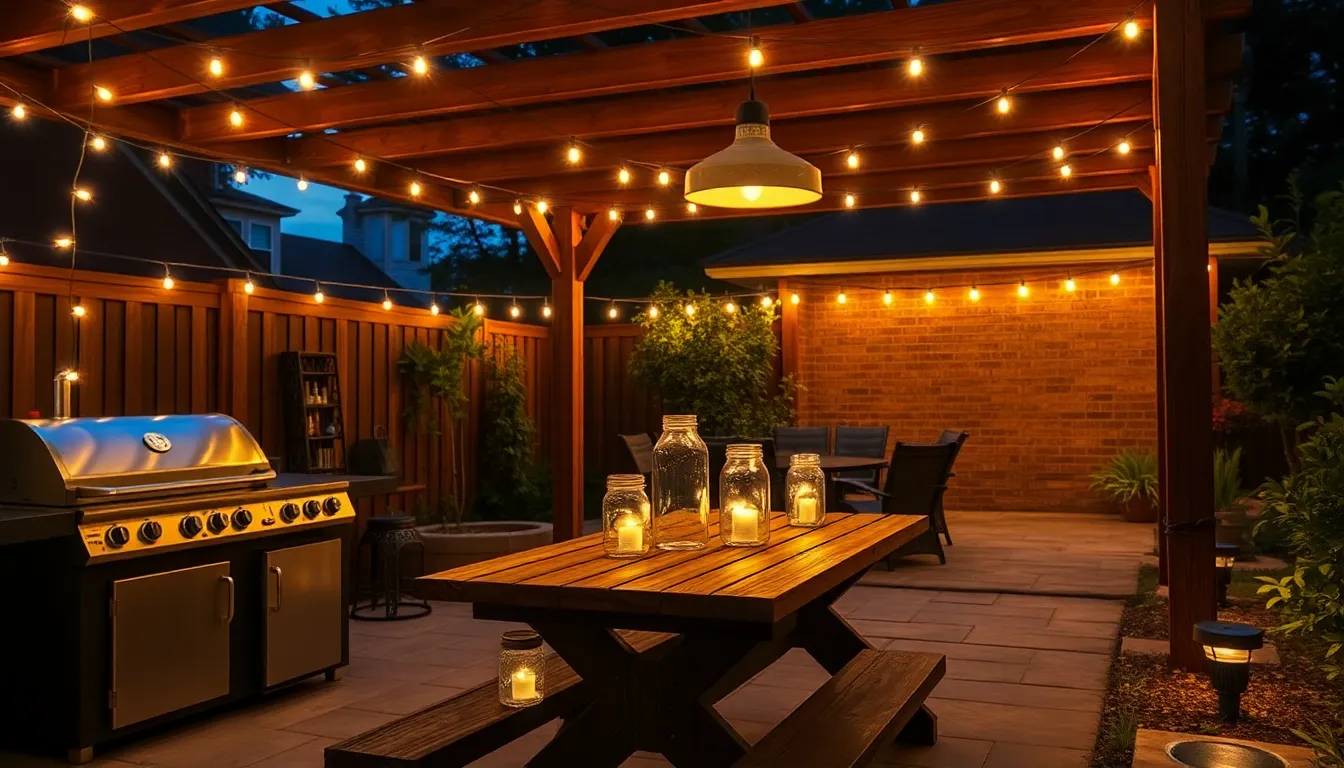
Transform your outdoor cooking space into an enchanting evening retreat with strategic lighting choices that won’t strain your wallet. Professional outdoor lighting installations typically range between $300 and $3,000, but our budget-friendly answers deliver stunning results for a fraction of that cost.
String Edison Bulbs for Warm Evening Atmosphere
Edison bulb string lights create an instantly cozy vintage atmosphere perfect for extending BBQ gatherings into the evening hours. We recommend hanging these versatile lights around pergolas, fences, or overhead beams to cast that warm golden glow everyone loves. LED versions offer energy efficiency and long-lasting performance, making them a smart investment for frequent entertainers.
Installation couldn’t be simpler since these lights require no special wiring or professional setup. Drape them in zigzag patterns across your patio ceiling or wrap them around support posts for dramatic effect. Most string light sets include built-in timers and weather-resistant construction, ensuring years of reliable outdoor use.
Use Solar Lights for Eco-Friendly Illumination
Solar powered lighting answers eliminate ongoing electricity costs while providing automatic illumination for your BBQ area. These eco-friendly options charge throughout the day and turn on automatically at dusk, creating effortless ambiance without any switches to remember. Pathway lights can line walkways leading to your grill station, while stake lights highlight landscaping features around your patio.
Motion sensor solar lights add an extra layer of security and convenience to your outdoor cooking space. Position them strategically near prep areas or storage zones where you’ll need hands-free illumination. Many solar options now include decorative elements like colored glass or artistic metalwork that enhance your patio’s visual appeal during daylight hours.
Create Lanterns From Mason Jars and Battery Lights
Mason jar lanterns filled with battery operated fairy lights offer a charming DIY solution that adds personal character to your BBQ setup. We love how these handmade fixtures provide soft, romantic lighting while avoiding any electrical work or installation costs. Fill clear jars with warm white LED strings or experiment with colored lights to match your outdoor decor theme.
Battery powered options give you complete flexibility in placement since you’re not limited by outlet locations or extension cord lengths. Consider adding decorative elements like sand, pebbles, or artificial flowers inside the jars for unique visual interest. These portable lanterns work beautifully as table centerpieces or can be hung from shepherd’s hooks throughout your entertaining area.
Install Practical Utilities Without Major Renovations
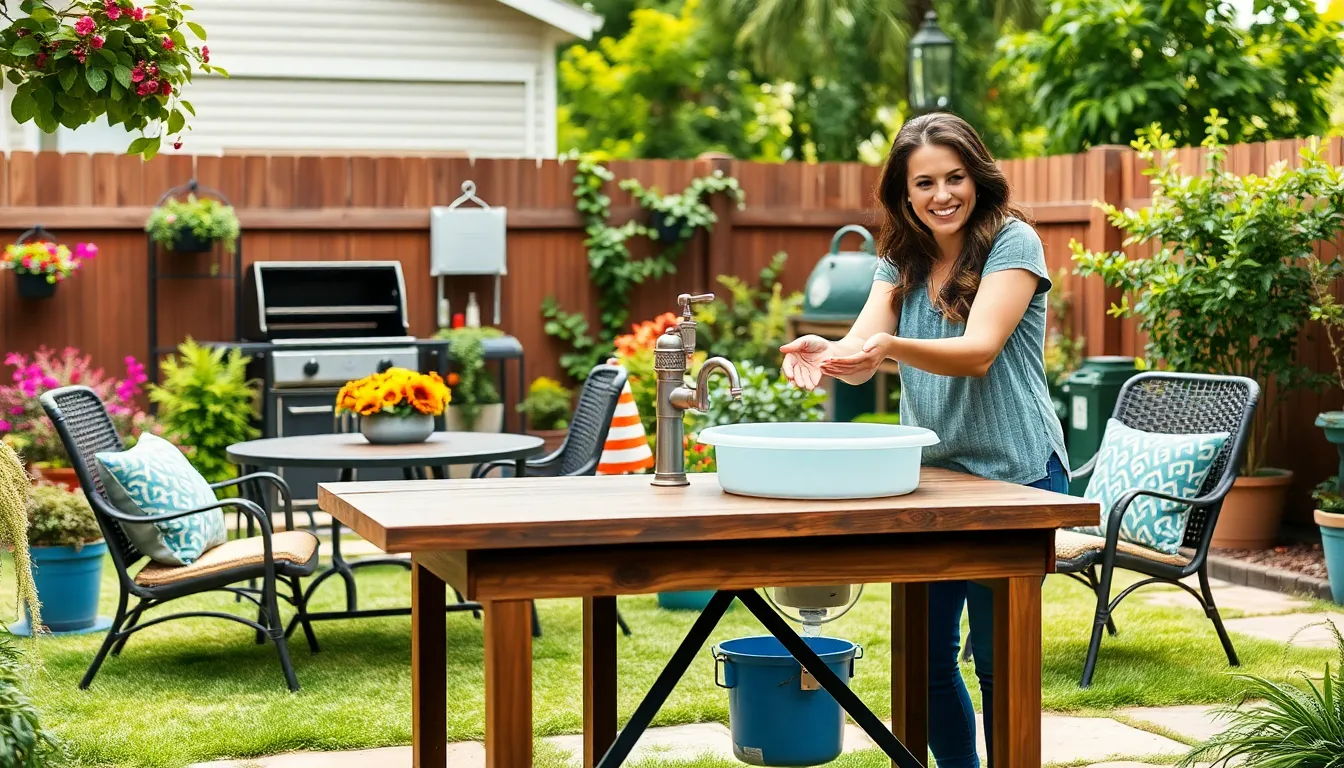
We can add essential utilities to our backyard BBQ area without expensive plumbing or electrical work. Smart answers help us create a functional outdoor cooking space while keeping renovation costs minimal.
Set Up a Portable Hand Washing Station
Portable hand washing stations eliminate the need for permanent plumbing while maintaining proper hygiene during our BBQ gatherings. We can create an effective setup using a sturdy table paired with a large basin and a foot pump water dispenser. This arrangement costs significantly less than installing outdoor plumbing and can be moved anywhere in our yard.
Essential components for our portable station include a weatherproof table, a deep basin for washing, and a hands free pump system that activates with foot pressure. We’ll want to position this station near our grill area but away from heavy foot traffic. Adding a small mirror and towel holder transforms this basic setup into a comprehensive washing area.
Storage answers keep our portable station organized and functional throughout the BBQ season. We can mount a small shelf underneath the table for soap dispensers and hand sanitizer. Plastic storage bins work perfectly for holding clean towels and keeping supplies dry between uses.
Create a Simple Outdoor Sink Using a Utility Tub
Utility tub outdoor sinks provide a permanent washing solution without the complexity of traditional plumbing installations. We can set up a large utility basin with a DIY drainage system that directs water into a gravel bed or large planter. This approach costs a fraction of professional sink installation while offering the same functionality.
Drainage options for our utility tub sink include several budget friendly alternatives to traditional plumbing. We can create a simple gravel drainage pit beneath the tub that naturally filters and disperses wastewater. Large planters positioned under the drainage spout work well for directing soapy water to plants that benefit from the extra moisture.
Installation steps require minimal tools and can be completed in a weekend. We’ll need to level the ground and create a stable base using concrete blocks or treated lumber. The utility tub sits securely on this platform while the drainage system handles all wastewater disposal naturally and effectively.
Install a Basic Outdoor Electrical Outlet
Basic outdoor electrical outlets can be installed without major renovation work when we hire an electrician for a simple connection to our existing home electrical system. We need a weatherproof outlet cover and proper GFCI protection to ensure safety around our grill area. This installation typically costs between $150 to $300 and provides power for lighting and small appliances.
Strategic placement of our outdoor outlet should be within 6 feet of our main grilling area but protected from direct water exposure. We can position the outlet on an exterior wall or install it on a weatherproof post if wall mounting isn’t feasible. The outlet should be easily accessible but high enough to avoid accidental water contact.
Safety considerations require professional installation to meet local electrical codes and ensure proper grounding. We must use outlets specifically rated for outdoor use with built in GFCI protection. Weather resistant covers protect the outlet when not in use and prevent moisture damage during storms or cleaning.
Maximize Space With Multi-Purpose Design Elements
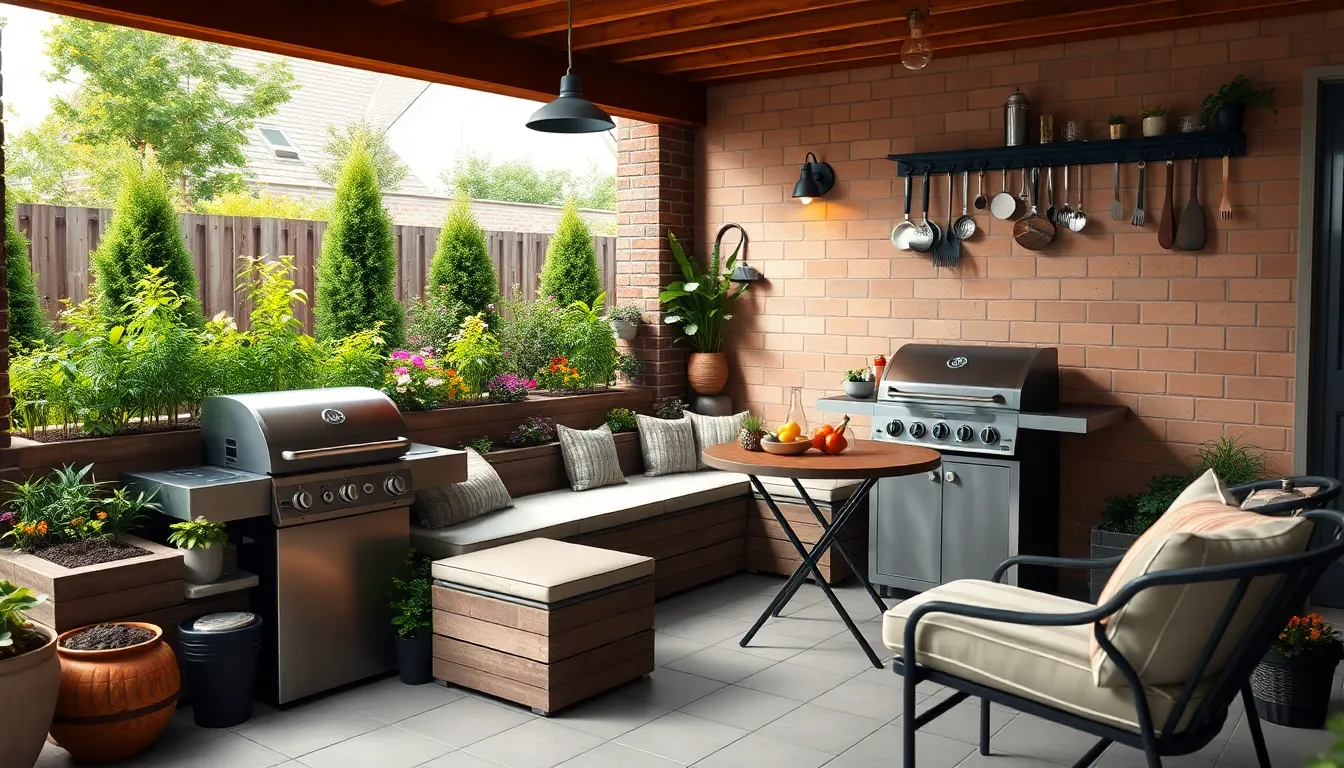
Smart design choices help us squeeze every bit of functionality from our backyard BBQ area without sacrificing style or comfort.
Combine Planters With Seating for Dual Function
Bench seating with built-in planters transforms ordinary furniture into living accents that serve two purposes at once. We can construct these dual-function pieces using simple lumber and waterproof planters, creating comfortable spots for guests while adding natural beauty to our outdoor space. Built-in planters eliminate the need for separate plant stands or decorative elements, maximizing functionality without additional cost or space requirements.
Corner L-shaped benches work particularly well for this design, as they naturally create planting pockets at the intersections. We’ll save money on both furniture and landscaping by choosing plants like herbs or small flowering varieties that guests can enjoy up close. These integrated seating planters also provide natural conversation starters during gatherings.
Use Vertical Space for Hanging Storage
Wall-mounted hooks and racks keep our BBQ tools organized while freeing up valuable counter space around the grill. We can install simple pegboard systems on fences or exterior walls to hang spatulas, tongs, and cleaning brushes within easy reach of the cooking area. Vertical storage answers cost significantly less than additional countertops or storage cabinets.
Magnetic strips attached to metal surfaces hold knives and small metal utensils securely and visibly. We’ll find that hanging pots and serving platters on sturdy wall brackets creates an attractive display while keeping essentials accessible. This approach declutters our prep areas and adds a professional kitchen aesthetic to the outdoor cooking zone.
Create Zones That Serve Multiple Entertaining Purposes
Seating walls function as both dining spots and casual gathering areas around fire pits or grills, maximizing the utility of every built element. We can design these walls at standard bench height (18 inches) to accommodate both sitting and table functions when paired with portable surfaces. DIY patio designs with integrated seating walls cost roughly $45 in downloadable plans, making them affordable alternatives to separate furniture pieces.
Concrete paver patios around 300 square feet can incorporate distinct cooking, dining, and relaxing zones while maintaining flow between areas. We’ll position our grill pad adjacent to the seating wall so it serves as both a cooking station and a social hub where guests naturally gather. Fire pit areas double as ambient lighting sources and additional cooking surfaces for s’mores or warming food.
Conclusion
Creating the perfect backyard BBQ area doesn’t require a massive budget or professional contractor. With some creativity and elbow grease we can transform any outdoor space into an inviting entertainment hub that rivals expensive outdoor kitchens.
The key lies in smart material choices and multipurpose design elements. From concrete pavers and reclaimed wood to repurposed furniture and vertical storage answers we’ve shown that style and functionality can coexist affordably.
Remember that your BBQ area should reflect your personal style while serving your practical needs. Whether you’re working with a compact patio or sprawling yard these budget-friendly ideas prove that memorable outdoor gatherings don’t depend on how much you spend but on how thoughtfully you design your space.
Frequently Asked Questions
What’s the most affordable foundation for a backyard BBQ area?
Concrete pavers are the most cost-effective foundation option. Use 12×12 inch pavers for their heat resistance and easy installation. For a more rustic look, repurpose reclaimed bricks at low or no cost. Consider building a gravel base underneath for stability and drainage, especially if you’re using portable grills.
How can I create a prep station without spending much money?
Convert rolling carts into mobile prep areas or repurpose thrift store medical carts for durability. Build a simple wooden counter with storage using affordable materials and protect it with quality sealant. You can also repurpose old tables like vintage sewing tables or dining tables into effective food preparation stations.
What are some budget-friendly seating options for BBQ areas?
Use cinder blocks topped with weather-resistant cushions to create sturdy benches that can be customized with paint. Arrange outdoor chairs in a circle around a DIY fire pit for cozy gatherings. Repurpose heat-treated wooden pallets into sofas and coffee tables with built-in storage compartments for maximum functionality.
How can I add shade to my BBQ area inexpensively?
Build a simple DIY pergola using affordable lumber for $200-$400. For immediate relief, use drop cloths or tarps that can be easily secured and stored. Plant fast-growing vines like morning glory and sweet peas to create natural shade walls that are low-maintenance and enhance the outdoor atmosphere.
What storage solutions work best for grilling essentials?
Build a wall-mounted tool organizer from reclaimed wood to hold grilling utensils. Use galvanized buckets for utensil storage that can be hung or placed around the grilling area. Create a spice station with mason jars for organized seasoning storage while adding a personalized touch to your setup.
Can I add utilities to my BBQ area without major renovations?
Yes, set up a portable hand washing station using a sturdy table, large basin, and foot pump water dispenser. Create an outdoor sink using a utility tub with DIY drainage. Install a basic outdoor electrical outlet for lighting and small appliances, ensuring proper safety measures are followed.
How can I maximize space in a small BBQ area?
Use multi-purpose design elements like bench seating with built-in planters. Utilize vertical space with pegboards and magnetic strips for tool storage. Create distinct zones that serve multiple purposes, such as seating walls that double as dining spots and fire pit areas for ambiance and additional cooking surfaces.

